Vacuum cleaners for shavings and sawdust: features, principle of operation and manufacture
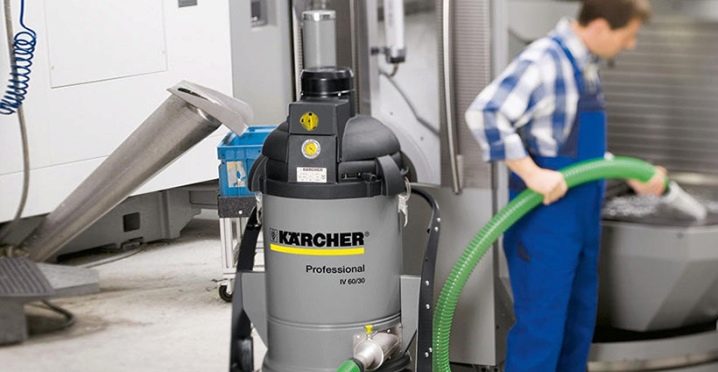
A household vacuum cleaner is a completely familiar and convenient tool for putting things in order in the house. But if you clean up the garage with a household vacuum cleaner, the result can be disastrous. And debris will remain on the floor and the vacuum cleaner will break.
The problem is that a household vacuum cleaner is designed only for cleaning dust and very small debris. In the workshop, the waste consists of fairly large sawdust, pebbles, chips and metal shavings. A household device cannot cope with such garbage.
Peculiarities
Usually the air stream is cleaned of debris by passing it through a cloth filter or a container with water. This is enough to hold dust and small household waste.
The chip and sawdust vacuum cleaner has a different design. There is no cloth filter in it, because it only creates unnecessary resistance to the air flow. Dust, shavings and sawdust are removed from the air stream in a centrifugal filtration apparatus, the so-called cyclone.
In large-scale industries, industrial vacuum cleaners are used to suck off shavings and sawdust from the working area of a woodworking machine. They are large, powerful machines, but they are built in the same way as small carpentry vacuums.
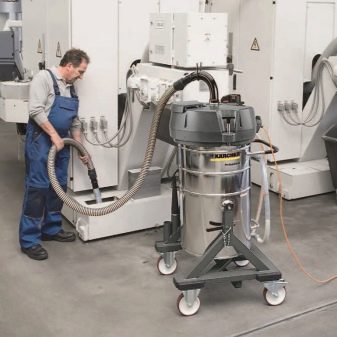

Principle of operation
The cyclone is primitive at first glance. It's just a large, round container (bucket or barrel). The incoming air stream enters the upper part of the container, and the air stream is directed horizontally along the wall. Due to this, the flow is spirally twisted.
Centrifugal force throws all solid particles of debris against the wall and they gradually collect at the bottom of the container. The air is light, so the purified air flow gradually calms down and collects in the center of the tank.
Vacuum in the cyclone body is created by suction of air from the branch pipe located strictly along the tank axis. The air in this part of the cyclone is already cleaned of dust, shavings and sawdust, and therefore can be sucked out by any pump of a suitable capacity. A common household vacuum cleaner is often used as a pump.
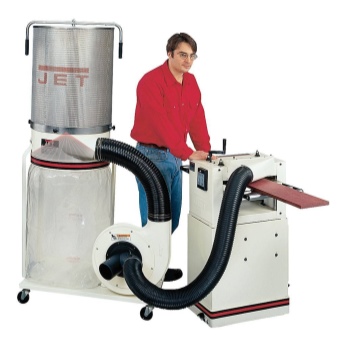

In the design of industrial vacuum cleaners based on a cyclone, as a rule, a special pump is used. Centrifugal pumps are usually used. Such a pump looks like a "squirrel wheel" with transverse blades, instead of spokes.
The wheel is housed in a snail-shaped body. A centrifugal wheel driven by an electric motor accelerates a mass of air around the ring and forcibly ejects it through the exhaust pipe located on the outer wall of the pump. In this case, a vacuum is formed in the center of the centrifugal wheel.
Centrifugal pumps are characterized by good performance and unpretentiousness.
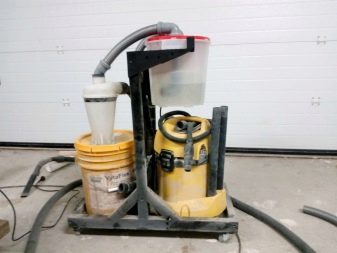

Such units are capable of sucking out even heavily polluted air, which makes them indispensable in the design of industrial vacuum cleaners based on cyclonic cleaning.
How to choose?
Choosing a vacuum cleaner for a workshop to remove shavings and sawdust, it is necessary first of all to decide what kind of pollution we will remove.
If work on metal is usually carried out, you will have to attend to the purchase or construction of a powerful stationary chip suction device.
As a carpentry vacuum cleaner for sucking off wood chips and wood dust, compact mobile units with a long flexible chip suction hose are usually used.
Most designs of hand tools for woodworking are already provided with connections for connecting a suction hose with a standard diameter of 34 mm, which exactly matches the size of the hose of a household vacuum cleaner.



How to do it?
So, an industrial vacuum cleaner for removing dust and shavings, consists of the following main parts:
- Vacuum pump;
- air ducts;
- cyclone filter;
- working nozzle.
Having set ourselves the goal of making a chip sucker with our own hands, we will consider which components and assemblies we can use ready-made, and which ones will have to be made from scrap materials.

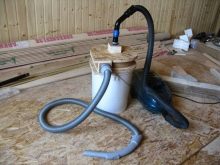

Pump
If we need to make a powerful and efficient vacuum cleaner for removing metal shavings in a locksmith's shop, we will have to find or make a powerful centrifugal pump. With sufficient accuracy, the snail and centrifugal wheel assembly can be made with your own hands from plywood and metal corners. To drive the pump, an electric motor with a power of 1.5-2.5 kW must be used.
If you plan to work in a carpentry workshop, it is easier to use a regular household vacuum cleaner as a pump. Considering that the shavings are much heavier than household dust, you need to choose the most powerful vacuum cleaner available.


Air ducts
If we are designing a high-performance chip sucker for a workshop, we must carefully consider the choice of dimensions and materials from which the air connections will be made.
The larger the diameter of the ducts, the less power loss. In a small-diameter pipe, not only the air flow is greatly inhibited, but congestions from accumulations of small chips and residues of wood dust can form over time.
Today on sale there are ready-made corrugated hoses for air ducts of various diameters. The spiral frame made of spring steel provides sufficient durability for such air ducts. When assembling air ducts from such corrugated hoses, you should carefully consider the sealing of joints and connections. The slightest gap leads to air leaks and a decrease in the efficiency of the entire chip suction.
It is very convenient to use polypropylene sewer pipes for assembling stationary air ducts. They already have cuffs and couplings. This ensures ease of assembly and disassembly, while guaranteeing a reliable and tight connection.
If we are constructing a wood chip extractor based on a household vacuum cleaner, we can use polypropylene pipes and nozzles with a diameter of 32 or 40 mm for air ducts.
These are the most common sizes, a wide range of fittings will allow you to easily assemble an ingenious structure. Polypropylene parts are also useful for making a cyclone filter.


Cyclone filter
The most interesting and complex unit in the construction of a chip suction. Of course, you can buy a ready-made cyclone. Industrial cyclonic air cleaning units are manufactured in a wide variety of sizes and capacities. They provide high cleaning efficiency and ease of maintenance.
But it is much cheaper and more interesting to assemble a homemade unit. It is not difficult to find ready-made drawings and technologies for assembling cyclone filters from scrap materials on the Internet. But the size and design of the cyclone filter will depend on what you end up with in your workshop.
In order to remove accumulated waste from time to time, the container must have a removable cover or hatch. In this case, the lid should fit very tightly, not allowing the slightest air leak.
As a working container, you can use:
- homemade container;
- a large plastic paint bucket;
- a plastic barrel with a capacity of several tens of liters.
With your own hands, a container for collecting chips and dust can be made, for example, from plywood. When making a wooden container, the joints should be carefully coated with sealant and the individual parts should be connected extremely tightly.
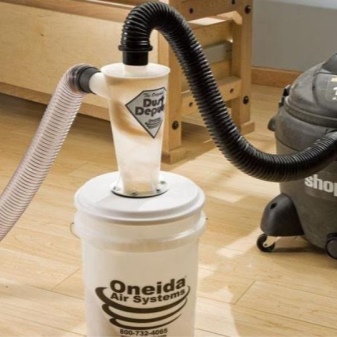

The most difficult thing will be to provide a tightly closing hole in the design for waste disposal. You can use, for example, the cut top of a paint can. Such a lid opens easily, but at the same time tightly seals the garbage discharge hatch.
It is convenient to use a tight-fitting plastic bucket for the cyclone filter housing. A variety of paints, putties and building mixtures are sold in such a container. From a bucket with a capacity of 15-20 liters, you can make a compact and mobile filter for a wood chip extractor based on a household vacuum cleaner.
The best cyclone filters for the workshop come from a plastic barrel with a tight screw cap. Such barrels are of the most varied capacity - from 20 to 150 liters. Just keep in mind that a square barrel will not work for making a cyclone. You definitely need a round one.
The key part of the cyclone is the suction device from the air tank and the supply of "dirty" air flow from the working nozzle. Air is sucked off vertically along the filter axis. The suction connection can be fixed directly to the center of the lid of our barrel or bucket.
Just take into account that the best results are obtained if the air is not sucked out directly from under the lid, but at a height of about half to two-thirds of the size of the container. Therefore, it will not be a short pipe that will pass through the cover, but a tube of a suitable length.


The dirty air flow is also supplied from above, but horizontally. And here is the trick. In order for the air flow to swirl along the wall of the cyclone, the inlet must be directed along the wall.
The easiest way to organize such a flow would be to install a corner as an inlet pipe. The air entering the branch pipe will turn its flow by 90 ° and will be directed along the cyclone wall. But in the elbow, the air flow is greatly inhibited. In addition, dust and shavings will surely accumulate in the corner.
A better solution is to install an inlet pipe in the form of a straight tube, mounted obliquely as close to the tank wall as possible. Such a branch pipe will allow impurities to get inside the cyclone without interference and accelerate well along the wall. Thus, a powerful spiral flow will be formed.
All connections should be made as tight as possible. During the operation of the chip suction, the cyclone body vibrates noticeably. It is imperative to ensure the best tightness, for which it is best to use elastic sealants used in the installation of windows and plumbing.

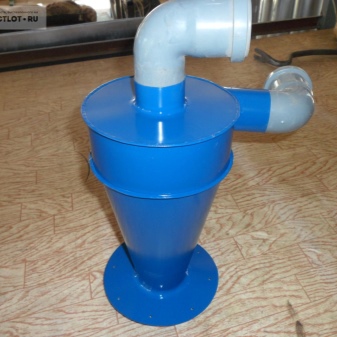
Working nozzle
If a stationary chip suction is being constructed for a metal-cutting machine, it is quite acceptable to assemble a rigid air duct structure fixed directly to the machine bed.
If the chip sucker is used in a carpentry shop, the hose of the working attachment should be quite long and flexible. Ordinary hoses of household vacuum cleaners are perfect for this.
It is especially convenient that the vacuum hoses usually fit easily one after the other. And also from the set of a household vacuum cleaner for suction of shavings and dust, the "crevice" nozzle for the hose is very well suited. And without a nozzle, a household hose, as a rule, fits tightly with the suction pipe of a hand-held jigsaw or a belt sander.



Features of operation
The air after the cyclone filter is still not completely cleaned of wood chips and metal dust. Therefore, the air ducts must be cleaned from time to time.
Therefore, it is undesirable to place the exhaust pipe of an industrial vacuum cleaner inside the workshop. It is best to run the air duct from the workshop outside from the air pump (or vacuum cleaner, if used).
Keep an eye on the filling of the cyclone body. The accumulated waste should not approach the central (suction) branch pipe closer than 100-150 mm. Therefore, empty the hopper in good time.

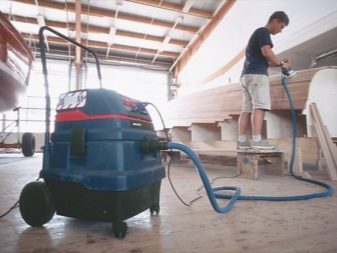
For information on the features of vacuum cleaners for shavings and sawdust, see the next video.








The comment was sent successfully.